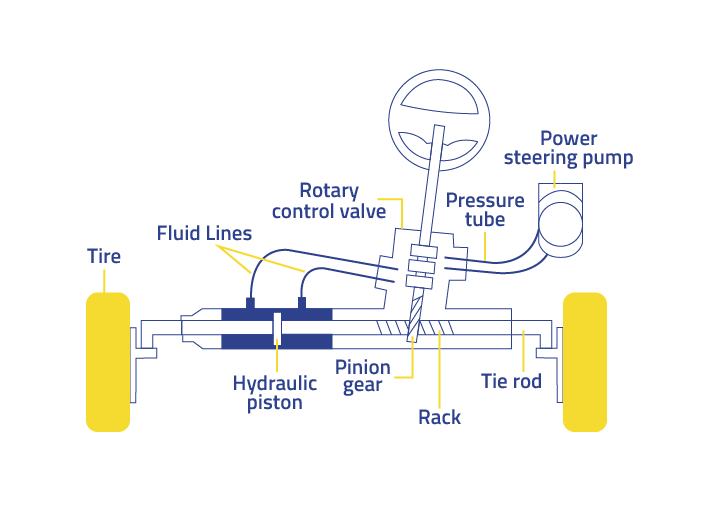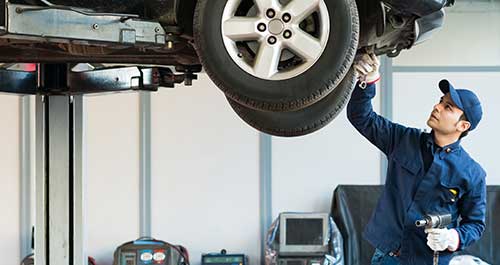While there are several types of steering systems used on the market, the two main ones are recirculating ball steering, which is mostly used for heavy vehicles, trucks and larger SUVs, and rack and pinion steering, which is commonly found on cars, small trucks and SUVs.
How does rack and pinion steering work?
Rack and pinion steering uses a gear-set to convert the circular motion of the steering wheel into the linear motion required to turn the wheels. It also provides a gear reduction, so turning the wheels is easier.
It works by enclosing the rack and pinion gear-set in a metal tube, with each end of the rack sticking out from the tube and connected to an axial rod. The pinion gear is attached to the steering shaft so that when the steering wheel is turned, the gear spins, moving the rack. The axial rod at each end of the rack connects to the tie rod end, which is attached to the spindle.
Rack and pinion steering ratios
Most cars need three to four complete turns of the steering wheel to go from lock to lock (from far right to far left). The steering ratio shows you how far to turn the steering wheel for the wheels to turn a certain amount. A higher ratio means you need to turn the steering wheel more to turn the wheels a certain amount and lower ratios give the steering a quicker response.
Some cars use variable ratio steering. This rack and pinion steering system uses a different number of teeth per cm (tooth pitch) in the centre than at the ends. The result is the steering is more sensitive when it is turned towards lock than when it is close to its central position, making the car more maneuverable.
There are two main types of rack and pinion steering systems:
- End take off – the tie rods are attached to the end of the steering rack via the inner axial rods.
- Centre take off – bolts attach the tie rods to the centre of the steering rack.
How does rack and pinion steering work with power steering?
When a rack and pinion system is connected to a power steering system, the design changes slightly. A cylinder with a piston in the middle is placed in the rack. There is fluid on both sides of the piston. When pressure is placed on the fluid on one side of the piston, it forces the piston to move, which turns the rack and assists with steering.
Common rack and pinion steering problems
As steering is essential for controlling your car, it’s important to diagnose and repair any steering issues as quickly as possible. Typical steering problems include:
- Very tight steering wheel
If it is becoming more difficult to turn your steering wheel, it’s a sign that there’s probably a problem either with your steering rack or a lack of pressure from the power steering unit. The solution could be as simple as adding more power steering fluid, but it’s best to get it checked. - Leaking power steering fluid
Power steering fluid levels only decrease and result in tight steering if there is a leak. This isn’t a big problem, however the consequences for leaving it too long include causing the steering gearbox and steering rack to overheat or gears to break. It is recommended to get this fixed when it is a simple (and cheap) task. Click here for more information about the causes of these leaks - Grinding noise when steering
A grinding noise from your steering gearbox comes from metal-on-metal contact, suggesting a lack of lubrication. You’ll be able to hear it clearly when you turn either left or right. Ask your mechanic to take a look at the problem, as your steering gearbox could need replacing. - Burning oil smell
Power steering fluid smells like burning oil, so if you smell it when driving it’s a sign that the steering gearbox is too hot. It’s best to stop your car as soon as possible and get the problem looked at it. Driving with an overheated steering gearbox can result in fire.
Discover more
Want to know more about the steering and suspension of your car? Take a look at MOOG TV. Full of interesting videos, useful tips and clear instructions, MOOG TV is the ideal place to learn more about your car.
The content contained in this article is for entertainment and informational purposes only and should not be used in lieu of seeking professional advice from a certified technician or mechanic. We encourage you to consult with a certified technician or mechanic if you have specific questions or concerns relating to any of the topics covered herein. Under no circumstances will we be liable for any loss or damage caused by your reliance on any content.



